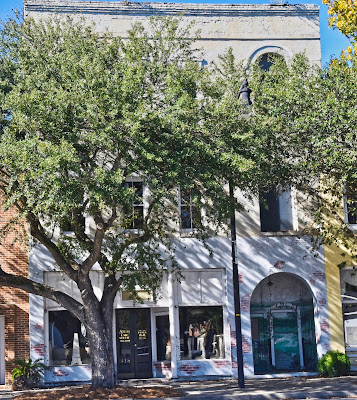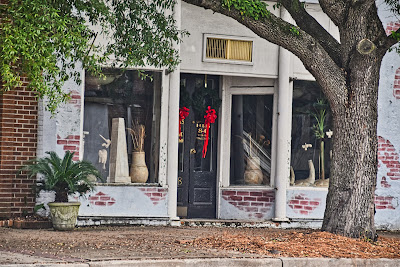Last week, the Town of Kingstree celebrated the re-opening of the municipal parking lot downtown. Over the past several months, contractors have made improvements to the 64-year old lot by enlarging it, repaving, and installing numerous planters throughout the space.
Planters are interspersed throughout the renovated and enlarged downtown parking lot.
In 1954-55, the Town of Kingstree entered six projects in the Better South Carolina statewide competition. One of the projects included two new parking lots in the town's business district. Sidney Dubin chaired the overall committee to oversee the projects, while the Town of Kingstree sponsored the parking lots, with Police Chief Billy Britton in charge of getting them established. The lot in the middle of the block surrounded by Hampton Ave., Main, Academy, and Mill streets, was designed for use by merchants and employees of downtown stores and businesses to free up street parking for shoppers. In addition, a second parking lot, no longer used for that purpose today, was created across Mill Street from Town Hall. That lot had a 25-car capacity.
This undated arial photo shows that before 1955, several buildings occupied the lot.
Parking may seem like a modern issue, but it has sparked controversy in Kingstree since at least 1901. That year, The County Record noted, "We understand there is a petition being signed around town, asking the County Commissioners to fence in the courthouse square and not allow people to hitch their horses or drive their vehicles in said yard." The paper went on to note that while this was nice for the town folks, it would be a great hardship on the folks who lived in the country. It concluded, "We scarcely think this step would be advisable at this juncture."
But the idea wouldn't die. The Grand Jury recommended an iron fence be erected around the courthouse square to keep horses and buggies out. The County Commissioners ignored the Grand Jury's recommendation. The Grand Jury expressed its great displeasure at being ignored.
In August, 1903, after the Grand Jury again strongly recommended fencing the courthouse square, a series of letters about the issue began appearing in The County Record, both pro and con. Samuel Singletary, a County Commissioner from the Lake City area, wrote, expressing his opposition to the fence. The county had too many other needs to indulge in such a "worthless expenditure," he said. Besides, the courthouse property belonged to everyone, and "no one should be restrained from hitching their livestock on the courthouse grounds," particularly as there was a scarcity of hitching rooms in town. If visitors to Kingstree could not hitch their horses on the courthouse grounds, they would have to pay 10 cents a stall for the privilege.
Former Sheriff J.D. Daniel wrote to express the opposite opinion. While he agreed with Singletary that the courthouse belonged to all citizens, he said the courthouse square had become a place for "gypsies and squatters to make nuisances of themselves, hanging about, smoking, and trying to sell spoiled fish." He noted that in recent years, he knew for a fact that juries had often "agreed to disagree" in order to escape the odors that wafted through the open windows of the courthouse from the grounds below. The time had come, he said, to landscape the public grounds around the courthouse into a parklike place.
At this juncture, The County Record had apparently changed its position, agreeing with Sheriff Daniel that something must be done to stop "turning into a cattle pen the precincts of our temple of justice."
And S.B Gordon thought the whole issue should be ignored. He believed that certain residents of Kingstree were pushing the idea so that they could make money by renting out their vacant lots as parking facilities. He said there were far worse things on the courthouse square than horses and buggies, citing drunk men and politicians as prime examples.
The County Commissioners, citing a lack of funds, postponed indefinitely any consideration of an iron fence. They did, however, agree to building a wooden fence in front of the courthouse and accepted the $72 bid of P.A. Alsbrook to do just that.
During the first week of July, 1907, attorney J.A. Kelley in open court asked the judge to direct the Grand Jury to recommend that the courthouse square no longer be used as a hitching post for horses. The Grand Jury included that recommendation and also recommended enclosing the courthouse square with an iron fence so that it would "not be used as a horse lot." This prompted an unsigned letter in the newspaper citing the inconveniences this would occasion. The writer noted that horses could be left at various stables in the area and that a lot owned by W.B. Wilkins could be fitted out with hitching posts. But what if they were all full? Would someone coming to pay his taxes have to stop near the cemetery and ask Mr. Epps if he could stake his horse on his property? The writer suggested that if the courthouse square was fenced, the county should have to provide 100 paved stalls at the rear of the courthouse.
The Courthouse and grounds with iron fencing in front of the square.
This time, though, the tide appears to have turned. The County Commissioners put the iron fence out for bids and awarded the contract to Kingstree Hardware, which had submitted the low bid of $425. Not long afterward, The County Record remarked on the "handsome appearance" of the new fence surrounding the courthouse square.
One wonders if the gentlemen so intent on maintaining their old way of life had any inkling that in just a few short years, they would have to begin to find ways of accommodating a new method of transportation. In January, 1910, Dr. E.T. Kelley became the first Kingstree resident to buy an automobile–a late-model Buick–and shortly thereafter attorney J.D. Gilland followed suit. The County Record noted, "Judging from the exhibitions along the streets, both are quite speedy." And by September, 1910, there were 32 automobiles in the county, compared to only 4 in 1909. And the issue of parking has continued to be an important one.







